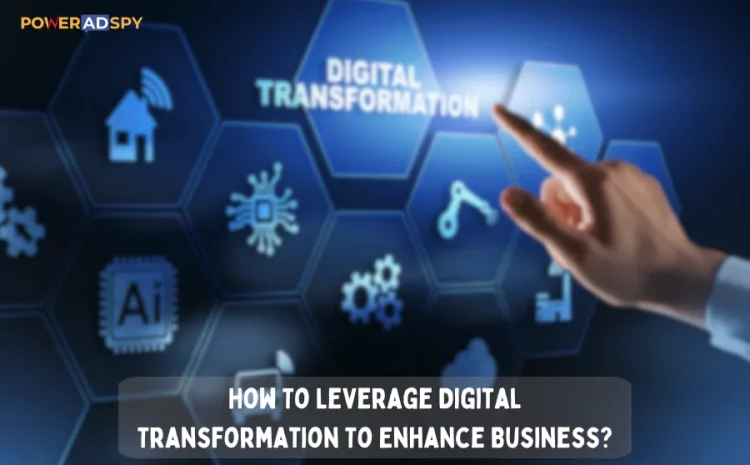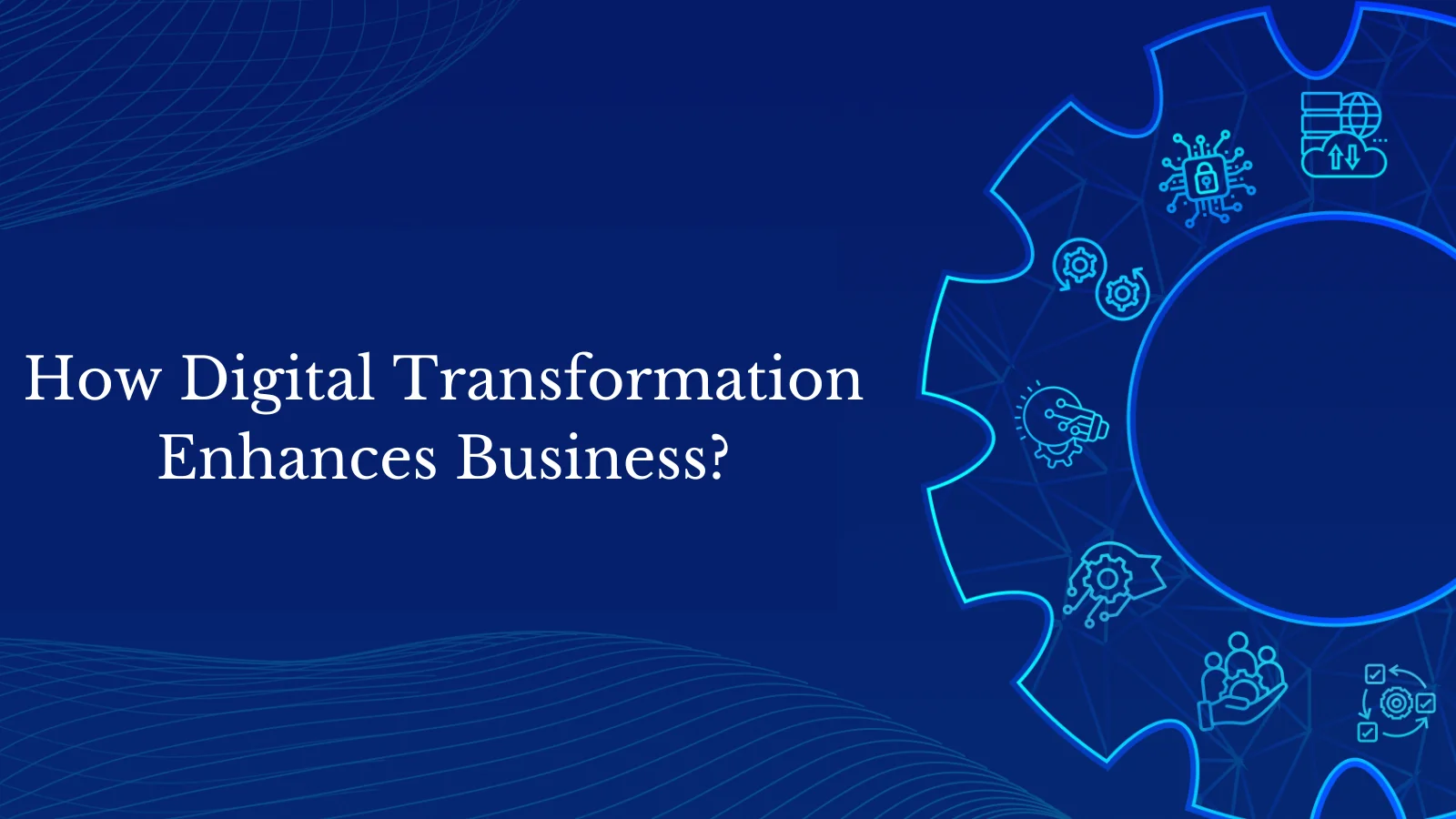How To Leverage Digital Transformation To Enhance Business?
“It’s not just great content that drives success—it’s how well you promote it.”
Marketing success isn’t just about great ideas. Instead, it is about execution, agility, and the right technology. Digital transformation is reshaping the way marketers and advertisers operate, but keeping up isn’t easy. Outdated systems, fragmented data, and inefficient workflows make it harder to connect with audiences and drive results.
The pressure is real: adapt or fall behind. But how can you make digitalization and lead generation work for your business? In this blog, we’ll explore the strategies you need to streamline operations, enhance customer engagement, and stay ahead in an ever-evolving digital world.
In a hurry? Listen to the blog instead!
What Is Digital Transformation?
At its core, digital transformation involves integrating digital technologies into everyday business operations. Companies adopt this change to improve efficiency and enhance customer service.
The journey of this transformation varies for every business. However, the goal remains the same—shifting from analog to digital processes for better performance. Research shows that 4 out of 5 executives implementing digital solutions report delivering improved products and higher value. They also try their hands on advanced ads spy tools like PowerAdSpy that help businesses stay competitive by analyzing marketing trends.
Digital or online transformation is more than upgrading outdated systems or migrating to the cloud. It requires a complete shift in mindset across all levels of an organization. Studies indicate that 87% of companies expect digital disruption in their industry, yet only 44% feel prepared for it.
Organizations embracing digital transformation are more adaptable to change. They let go of outdated methods, take calculated risks, and explore new opportunities to drive growth.
Why Marketers Must Lead The Digital Transformation Strategy?
Who in your company truly understands the customer journey? Most businesses would point to the marketing team. However, studies show that CMOs are less involved in digital or automation transformation than other C-suite executives.
If your automation strategy follows this trend, it may be time for a change. Here’s why:
A great product or service alone doesn’t guarantee success. Businesses need a strong marketing strategy to build brand awareness, attract new customers, and retain existing ones. Marketing professionals are no strangers to digital transformation. Advances in technology have revolutionized marketing more than almost any other industry.
In just one generation, marketing has shifted from traditional channels like direct mail, print ads, and radio to digital platforms, including SEO, PPC, email, and online content. These innovations didn’t intimidate marketers—they embraced them as game-changers.
The digital transformation strategy has created new opportunities to understand customers and craft engaging messages. But the shift isn’t over. The digital world keeps evolving, and marketers know they must adapt quickly. Digitalization is no longer optional—it’s essential for success.
Role Of Digital Transformation
Digitalization in marketing is about moving from using digital tools to fully optimizing them for better results. It’s not just about being online—it’s about making every digital channel work smarter. By improving how you use these channels, you gain deeper insights that shape your strategy and enhance the customer experience. Digitalization helps advertisers refine their approach, making campaigns more data-driven and effective.
Make The Most of Your Digital Channels
Start by evaluating your current marketing tools. Look at your website, social media, analytics, automation tools, and customer database. Are they delivering real value? Could they work better together? The right tools, including ad intelligence software, give you a competitive edge. A full review helps ensure you’re using the best platforms to reach your audience. Digital transformation is about streamlining these efforts to maximize impact.
Connect the Dots Between Platforms
Having the right tools isn’t enough—they need to work together. If your systems don’t communicate, you miss out on valuable insights. Switching between multiple platforms to track a customer’s journey wastes time. A customer data platform (CDP) bridges this gap, bringing everything into one place.
This connection allows you to see the bigger picture, helping you refine your ad strategies and create more targeted campaigns. Digital automation makes this integration seamless.
Improve The Customer Experience
Better integration means better data. When you have a complete view of your marketing funnel, it’s easier to spot gaps to fix them. You can refine messaging, optimize ad placements, and improve audience targeting. The result? A more personalized, engaging experience for your customers.
With ad intelligence software, you can track performance, adjust campaigns in real-time, and ensure every ad dollar is well spent. Digital transformation empowers advertisers to make smarter, data-backed decisions.
PowerAdSpy- Advanced Ad Intelligence Platform
PowerAdSpy is a comprehensive ad intelligence tool designed to help businesses analyze and optimize advertising campaigns across various social media platforms. It offers valuable insights into competitors’ strategies, enabling users to enhance their advertising efforts.
Key Features:
- Extensive Ad Database: Access millions of ads from over 100 countries, ensuring a vast repository of advertising content to explore and analyze.
- Advanced Search & Filtering: Utilize robust search algorithms to find ads based on keywords, advertisers, or specific domains. This feature allows users to pinpoint relevant ads efficiently.
- Ad Position Filtering: Analyze ad performance by segmenting ads based on their positions, such as news feed or side locations, to determine which placements yield the best conversions in your niche.
- Bookmarking Capability: Save compelling ad concepts with a single click, creating a personalized inventory for future reference and campaign inspiration.
- Engagement Metrics: PowerAdSpy provides detailed engagement metrics, including likes, shares, and comments, to identify high-performing ads within your niche.
- Video & Image Ad Integration: Explore a growing collection of video and image ads, providing insights into the types of content that resonate with your target audience.
- Geotargeting Information: Obtain precise geotargeting data to identify audiences interested in your products or services, enhancing the effectiveness of your campaigns.
- Call-to-Action Analysis: Determine the most effective calls-to-action in your niche by analyzing successful ad campaigns, aiding in crafting compelling CTAs for your ads.
- Platform Integrations: PowerAdSpy integrates with multiple advertising platforms, including Facebook, Instagram, YouTube, Google, and more, allowing users to research and analyze ads across various channels.
By leveraging these features, PowerAdSpy enables businesses to refine their advertising strategies, gain a competitive edge, and drive better results in their marketing campaigns.
Key Areas Of Digital Transformation In Advertising
Digitalization is reshaping the advertising industry, helping businesses stay competitive in a fast-changing market. According to the MIT Sloan Management Review, enterprises must focus on three key areas to succeed:
- Customer Experience – Brands must use technology to understand their audience better, drive customer growth, and create multiple touchpoints. A strong digital strategy helps advertisers connect with consumers through personalized and data-driven campaigns.
- Operational Processes – Automating workflows, leveraging digital tools, and analyzing performance data improve efficiency. Advertisers who embrace online transformation can streamline operations and make informed decisions that boost ROI.
- Business Models – Companies must integrate digital tools into their offerings, launch digital products, and expand services globally. A well-planned strategy allows advertisers to reach wider audiences and create new revenue streams.
How To Leverage Digital Transformation To Enhance Business?
According to Google, a typical B2B buyer conducts about 12 online searches before purchasing. They also consume around 13 pieces of content from vendors and third-party sources. Digital automation and transformation are crucial in this process, ensuring businesses stay relevant in the digital space.
To attract these buyers, brands must have strong digital channels. Content marketing helps establish authority and showcase expertise. High-ranking content in search results requires investment in organic SEO. Digital strategy ensures that potential customers find your content easily.
A well-optimized website enhances user experience. It should be simple to navigate and provide quick answers. If you sell physical products, an eCommerce platform is essential. For services or apps, a self-guided digital experience improves conversions. Digital transformation allows businesses to adapt to customer needs effectively.
A study of 3,600 SMBs(small and medium-sized businesses) shows that 51% are increasing their transformation efforts. The pandemic accelerated this trend, highlighting the importance of becoming digitally advanced. The key motivators include cost reduction, innovation, operational efficiency, business growth, and productivity enhancement.
These benefits are within reach for B2B SMBs. Implementing the right digital strategy strengthens transformation and accelerates progress.
Digital Transformation Roadmap
-
Recognize Behavioral Changes
Research indicates that fewer than one-third of companies successfully achieve transformation. However, many businesses now have no alternative. In today’s fast-changing landscape, adapting digitally is no longer optional.
Your business has likely adjusted to recent challenges. But are you actively embracing change, or simply doing the minimum to survive? Businesses waiting for a return to “normal” risk missing significant growth opportunities. Digital strategy plays a pivotal role in adapting to these new realities.
Change can be uncomfortable, but it often leads to progress. Businesses that embrace digital transformation find themselves thriving even in challenging conditions.
-
Adopt A Customer-Centric Mindset
Reports say that 86% of senior marketers emphasize a seamless customer journey. A strong digital strategy enhances engagement by delivering valuable content. Instead of telling customers what to think, brands should invite them to interact through informative and engaging content.
This shift redefines how businesses communicate with consumers. Traditional advertising viewed businesses and customers as separate entities. Today, successful brands use transformation to integrate their presence into consumers’ daily lives. Engaging in social media, vlogging, and mobile optimization fosters deeper customer connections.
-
Find The Right Technology Stack
Digital transformation goes beyond adopting software. The right technology stack is essential for business growth. Many companies quickly transitioned to remote work without evaluating the best digital tools. Now is the time to reassess and optimize those choices.
Remote communication and collaboration tools are long-term investments, not temporary solutions. Businesses should experiment with different tools to determine the most effective workflow. A strong digital strategy ensures seamless integration of these technologies for better productivity.
Technology should serve as the operational core. Businesses already use CRMs and automation tools, but an advanced technology stack unifies all digital efforts. The right digital transformation approach integrates:
- Search and lead generation
- Email marketing
- ROI measurement
- Website visitor tracking
- High Converting Landing page optimization
- Real-time sales data
- Social media marketing
This interconnected system helps businesses track marketing effectiveness and revenue growth.
-
Invest In Digital Marketing
B2B SMBs traditionally spend on event marketing and sales travel. With those budgets now available, investing in digital marketing is a smarter choice. Online transformation enhances audience engagement and increases conversion rates.
Key investment areas include:
- MarTech tools: Enhancing automation and campaign tracking.
- Website improvements: Adding eCommerce features, personalization, and chatbots.
- Content marketing: Strengthening organic SEO for greater visibility.
- Data science and AI: Using artificial intelligence and machine learning for predictive insights.
Strategic spending in these areas supports digital transformation, driving profitability and business expansion.
-
Empower Your Team
Successful digital automation requires employee support. Businesses must equip their teams with the right tools and resources. Adapting to change is challenging, and many employees are adjusting to remote work under difficult conditions.
Providing the right digital technology ensures smooth collaboration. A unified digital strategy helps employees stay connected and productive. Transparent communication about transformation fosters employee engagement and trust. When teams understand the purpose behind these changes, they are more likely to embrace innovation.
-
Enhance The Digital Customer Experience
B2B buyers are already familiar with digital interactions. However, businesses must now enhance these experiences through digital transformation. Brands should explore virtual events, video interactions, and emerging technologies like augmented reality (AR) and virtual reality (VR). These tools create engaging customer experiences that compensate for the lack of face-to-face interactions.
-
Explore New Opportunities
Businesses with digital models have remained resilient, while others have pivoted to sustain revenue. Businesses like restaurants now offer online ordering and delivery. Gyms provide virtual fitness classes. Bakeries sell DIY baking kits.
Transformation enables businesses to explore new opportunities beyond their original models. With the right digital strategy, companies can expand offerings and reach new customer segments.
-
Expand Your Customer Base & Build Trust
Small businesses reliant on local foot traffic have been significantly impacted by lockdowns. Digital transformation allows them to expand beyond geographical limitations. With the right digital strategy, even small businesses can achieve global reach.
However, scaling online requires trust-building. Unlike physical stores, where service quality fosters loyalty, online businesses must establish credibility through brand storytelling, thought leadership, and content marketing. Engaging customers through social media and valuable content strengthens brand reputation and authority.
Businesses that invest in transformation gain a competitive edge. A strong digital strategy ensures long-term success, allowing marketers to adapt, grow, and thrive in an evolving marketplace. Now is the time to embrace change and make digital transformation a priority.
Read More
How To Create A High Converting Landing Page?
What Is The Key Role Of A Lead Generation In Marketing?
The Bottom Line
Digital transformation isn’t just a trend—it’s a necessity for businesses looking to stay ahead. Embracing new technologies, refining strategies, and optimizing processes help companies improve customer experiences and drive long-term success. The key is continuous adaptation.
Tools like PowerAdSpy make this journey easier by providing deep insights into ad campaigns, competitor strategies, and audience engagement. With the right ad intelligence, businesses can make data-driven decisions that fuel growth.
The digital world keeps evolving, and those who leverage smart tools and stay agile will always have the edge. Transformation isn’t a one-time effort—it’s an ongoing process.
Frequently Asked Questions
Q: What Are the Four Key Areas of Digital Transformation?
Digitalization revolves around four essential areas that drive business growth and efficiency.
- Process Transformation – Companies enhance their operations by adopting new technologies to streamline workflows and boost efficiency.
- Business Model Transformation – Organizations rethink their core strategies, shifting to innovative models that align with evolving market demands.
- Domain Transformation – Businesses explore new digital opportunities, expanding into different industries or markets using advanced technology.
- Cultural & Organizational Transformation – A shift in mindset and workplace culture enables teams to embrace digital advancements and adapt to change effectively.
Que: What are the Three P’s of Digital Transformation?
Transformation revolves around three essential elements: People, Process, and Platform.
- People – The driving force behind innovation and digital adoption.
- Process – Streamlining workflows to enhance efficiency and effectiveness.
- Platform – Leveraging technology to support and sustain transformation efforts.
Que: What are the stages of Digital Transformation?
To successfully navigate digital transformation, organizations go through six key stages:
- Traditional Processes & Business as Usual – Relying on conventional methods with minimal digital integration.
- Present & Active – Experimenting with digital tools but lacking a unified strategy.
- Formalized – Establishing structured digital initiatives with clear objectives.
- Strategic – Aligning digital efforts with long-term business goals.
- Converged – Integrating digital processes across the organization for seamless collaboration.
- Innovative & Adaptive – Continuously evolving and leveraging emerging technologies to stay ahead.









